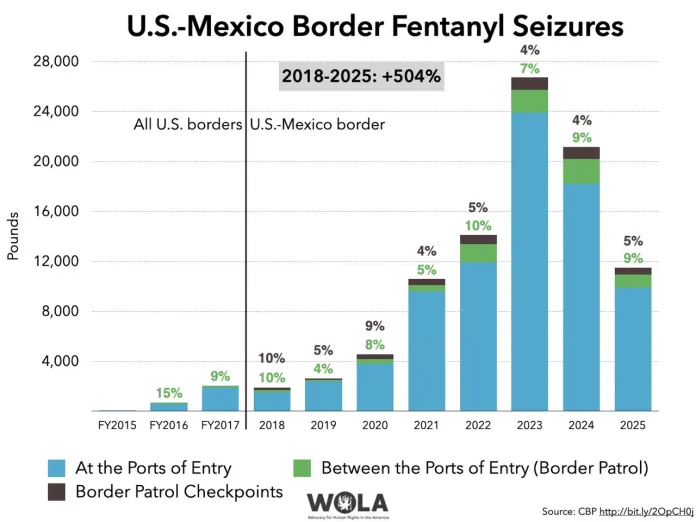The amount of fentanyl being seized by federal law enforcement at the nation’s border has decreased sharply over the past year as President Donald Trump has commanded the government to shut down the border to the deadly drug.
U.S. Customs and Border Protection interdicted almost half as much fentanyl in fiscal 2025, which ended in September, as in 2023.

Government officials and private sector experts suggested a variety of reasons for the decrease in seizures, including the drug being produced in a new non-pill form, reduced demand in the United States, problems with production in Mexico, and better evasion of U.S. federal police at the border.
The fentanyl epidemic
Fentanyl is a legitimate pharmaceutical drug reserved for rare medical situations and has been knocked off by Chinese chemical suppliers and Mexican cartel manufacturers in recent years.
More than 6 billion possibly lethal doses of fentanyl were seized by federal law enforcement at the border in the government’s 2023 year, which ended in September 2023. It was enough to kill all 330 million people in the U.S. 18 times — but plenty more have made it into the country undetected.
The latest Centers for Disease Control and Prevention data indicated that 109,000 people died from drug overdoses in 2022, with 70% of them tied to a synthetic opioid such as fentanyl. Deaths in which the user did not know they were consuming or injecting fentanyl are increasingly referred to as poisonings rather than overdoses.
Because fentanyl can be made year-round and smuggled into the U.S. in small doses, cartels have flocked to trafficking it into the country instead of substances such as marijuana and cocaine. They also use it as the main ingredient in fake prescription pills that make their way into the U.S., which can appear identical to real prescription sedatives, including Xanax, Percocet, and Oxycodone.
On social media, users can order their drug of choice to be delivered by mail or in person, as easily as ordering fast food for delivery through an app. The difference is that the drug can be filled with anything and often is not the highly regulated pharmaceutical drug that the buyer believes it is.
Fentanyl ebbs and flows
In 2025, CBP interdicted 12,000 pounds of fentanyl,11,500 pounds of which were stopped at the U.S.-Mexico border. Roughly 85% of all fentanyl was caught by CBP’s Office of Field Operations officers at the ports of entry as opposed to Border Patrol agents, federal data show.
This suggests that smugglers are trying to bring the drug in through commercial vehicles and body carriers as opposed to moving it between the ports of entry, where illegal immigrants walk across the border.
Fentanyl seizures dropped about 50% since the November 2024 election and early 2025. Nearly 22,000 pounds of fentanyl were seized by CBP in 2024, compared to 12,000 in 2025.
Todd Bensman, formerly the senior national security fellow at the Center for Immigration Studies in Washington, attributed the downturn to Trump’s tariff threat against Mexico.
“In December and January, President-elect Trump threatened devastating trade tariffs against Mexico if they did not seriously crack down on cartel production and smuggling even before he entered office,” Bensman wrote in an analysis. “From October 2024 to January 2025, Southwest Border seizures of fentanyl fell from 2,000 pounds in 85 seizure events, to 990 pounds in 47 seizure events, CBP seizure data shows. Then in February 2025, seizures plummeted even further to 590 pounds in 45 events.”
The White House touted the decline in fentanyl seizures as an all-out defeat of the drug.
“In just a few short months, the Trump Administration was able to fully secure the border and halt the flow of illegal drugs being smuggled into our country,” White House spokeswoman Abigail Jackson wrote in an email. “The Administration’s highly successful efforts at closing the border and removing dangerous criminal illegal aliens from our communities, along with prosecuting violent drug traffickers and targeting transnational cartels, means less illegal drugs are circulating in American communities.”
Reasons for the drop
Adam Isacson, director for defense oversight at the Washington Office on Latin America, offered a plethora of possible reasons that less fentanyl is being seen at the border.
Isacson’s “plausible but unconfirmed hypotheses” include reduced demand in the U.S. as drug users have learned about fentanyl’s lethality; infighting among Mexican suppliers after a Sinaloa cartel faction reportedly issued an order to stop making fentanyl; “initial results from the Biden administration’s installation of new scanners at ports of entry and pursuit of intelligence-based operations to disrupt Mexican criminal organizations, particularly in Sonora”; “stepped-up Mexican government efforts against laboratories and precursor chemicals”; “tunnels or other robust new smuggling modalities may be in use, and CBP may not have detected them yet.”
CBP got out ahead of speculation, saying, “[A]ny suggestion that CBP’s efforts are slowing down is simply incorrect.”
“Smugglers continuously shift tactics — especially from pills to powder, which is far more potent and concealed in smaller loads. CBP is adapting faster,” a CBP spokesperson wrote in an email. “Fentanyl remains one of the most lethal hazards to our homeland, and CBP will continue hitting it at every point — source, transit, and border — with relentless focus.”
CBP’s approach includes pushing the borders out, sending its Air and Marine Operations agents far beyond the southern border to identify suspicious boats and planes that could be trafficking the drug to the U.S.
FACT CHECK: DOES TRUMP NEED TO EXPAND H-1B VISAS TO ADDRESS LACK OF ‘TALENTED’ WORKERS IN U.S.?
The Trump administration has worked to keep the issue front and center, particularly through Republicans’ efforts in Congress, increasing public awareness, and possibly reducing demand.
In June, Congress passed legislation that permanently classified fentanyl-related substances as Schedule I under the Controlled Substances Act, the highest possible rating.

